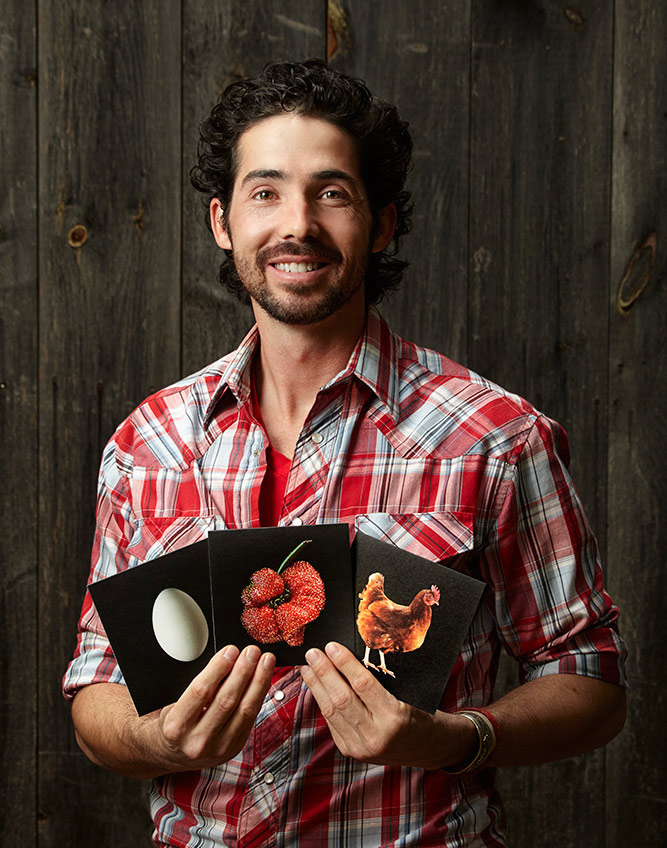From Darkroom to Greenhouse: A Photographer’s Journey
Jonathan Beckerman’s odyssey, from the world of high fashion photography to creating pictures of vegetables on a Connecticut farm, all began with 10 tomatoes. Jonathan, a 1999 Hamden Hall alumnus, had moved to Los Angeles after his 2003 graduation from Ithaca College, where he majored in cinema and photography and minored in art. In the City of Angels, Jonathan found success as a commercial fashion, celebrity, and luxury lifestyle photographer. One day, he decided to start composting—a challenging task in the middle of LA. Hoping no one would notice, he tossed some rotten tomatoes on a mound of rocky soil near his apartment stoop. A week later, a neighbor informed Jonathan that he had a green thumb. The decomposition had sprouted some vegetables—10 new tomatoes to be exact!
“I questioned, why isn’t everybody doing this?” Jonathan recalled. “It was a powerful experience."
So powerful, in fact, that Jonathan packed up his equipment and moved back east, investing in a homestead at Wiltshire Farm in New Milford, Conn. Jonathan describes Wiltshire as an organic, hobby farm, and he considers himself a Modern Sustainable Pioneer™, exploring the ancient ways of survival in today’s world, with modern innovations. Likewise, his photography has taken a major shift, evidenced by his recent collection, A Campaign for Sustainable Living. Last fall, part of that collection was displayed at Hamden Hall’s Inaugural 2014 Alumni Art Show.
“The collection is a visual database of organic foods designed to encourage an intimate connection for nature’s edible designs,” Jonathan said. “I consider these works the voice of Mother Earth speaking out against industrial farming complex, imploring people to take the seeds of a healthy future into their own hands—to tell the story of the sustainable living movement.” Looking back, Jonathan can trace his affinity with nature to age 13. “I fell in love with nature’s ability to bring me into the moment,” he said. “Later, the camera became my tool to celebrate the now.”
Initially, however, his camera led him to LA, producing his collection titled, Luxury Lifestyle—featuring expensive cars, luxury home decor, multiple million dollar estates, etc. “That body of work celebrates excess and exteriority, whereas my new body of work focuses on interiority, minimalism, and food freedom with the undertones of a modern civil rights movement,” Jonathan said. “In a way, sustainable practices are the real causes to celebrate, not the Kim Kardashians or propaganda. ”Jonathan’s photographic transformation mirrors his life. Before LA, he was a more health conscious athlete. At Hamden Hall, he helped secure a baseball Fairchester Championship for the Hornets. At Ithaca, he continued playing as 1st team all conference-closing pitcher. After college, he moved to LA, where he thought he was living his dream, photographing the glamorous life.
“But I learned there was more to health than fitness, and more to life than glamour,” he reflected.
Jonathan’s sentiments are illustrated in his Sustainable Living’s flagship image—a close-up of a ripe heirloom tomato that he photographed in LA. It symbolizes his transition from the smoggy distractions of the celebrity lifestyle to the vanguard of the sustainable living movement. “I cut it in half for lunch,” he recalled. “It looked like a heart; peppers look like lungs. I bit into it and it blew my mind how good it tasted. It was right there on the spot I photographed it—on a black, minimalist background to look as the earth does from a distance, because by nature, it is all of similar design and they feed off one another.”
Meanwhile, Jonathan was still full steam ahead into fashion and celebrity game. Then he asked himself, “What was I really supporting? Was I helping to sell a thing I didn’t really believe in anymore?“
SUSTAINABLE FUTURE
Once back in Connecticut and on the farm, Jonathan started growing and photographing vegetables. Like that first LA tomato, these images—included in Sustainable Living—are very much, in Jonathan's words, “sculpted with light.” His photography technique makes them jump off the page. Using tools traditionally applied to high-end commercial products and people, Jonathan strives “to bring something to life in the pop-art style—punctuate it!”
The tension in Jonathan’s work, he believes, traces to issues of responsible consumerism “Each purchase is a political decision or a vote for how we want the future to be,” Jonathan said. “I strive to use my own life as example: We all have this responsibility. ”Thus, Jonathan is now growing his own food and building his own reclaimed furniture, which he also sells. He found himself “creating and re-creating everything, from commercial endeavors to recycled functional home designs.” His photography showcases his esteem for organic farmers, whom he considers part botanists, part soldiers for health.
Jonathan is also branding his images to organic T-shirts (visit groworganicgo.com), hoping to inspire people to "be part of a growing movement." His "ag-tivist" 100 percent organic shirts have drawn attention, leading to invitations to speak about art and activism at local high schools and colleges. Jonathan’s goal is to bring people closer to their food instead of gobbling it down without any awareness. He dedicates his life at this point towards “selling solutions and not purchasing problems.” Going forward, Jonathan hopes to take part in the first sustainable living community in Connecticut state history, Rocky Corner, an Eco-Cohousing Dynamic Governance Village that is breaking ground in Bethany in April. His powerful images were accepted into a national art competition, titled You Art What You Eat, hosted by the Union Street Gallery in Chicago.
